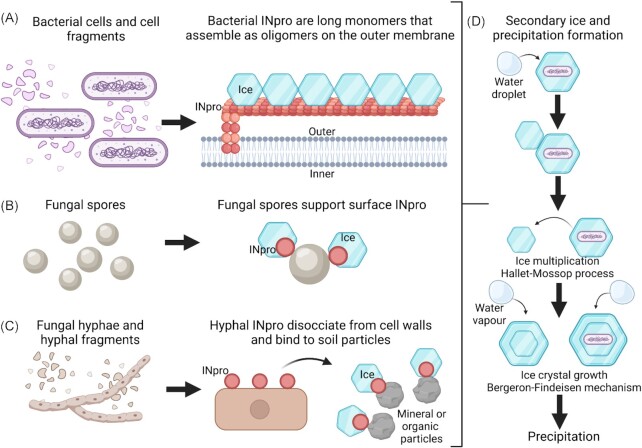Figure 6.
Biophysical role of atmospheric microorganisms in ice nucleation. An important biophysical interaction of atmospheric microorganisms with cloud formation is ice nucleation by specific microbial proteins that contributes to precipitation and the hydrological cycle, as well as impacting microbial deposition from the atmosphere to surface habitats. (A)Bacterial ice nucleating proteins (INpro) are long repetitive proteins that are anchored on the surface of the outer membrane and nucleate ice through a yet to be fully resolved mechanism. They may be cell associated or retain activity in cell fragments. Monomers or small oligomers nucleate ice at temperatures from −7 to −10°C and higher order oligomers of INpro form at well-defined sizes that nucleate ice between −2 and −5°C. Fungal spores and hyphae are associated with INpro that exhibit different molecular structure and properties than those in bacteria, but they are yet to be fully described. (B) Fungal spores are the dominant state for fungi in the atmosphere and support surface-associated INpro and ice nucleating activity. (C) Fungal hyphae occur very rarely in the atmosphere and so the major contribution arises from fungal INpro that are easily dissociated from cell walls and adhere to soil particulates that subsequently become aerosolized. (D) Low concentrations of atmospheric INpro nucleate cloud ice and may induce subsequent secondary ice formation via the Hallet–Mossop process. This process involves freezing of supercooled cloud droplets that encounter primary ice particles (riming) and subsequent ejection of frozen droplets that form independent ice particles (splintering). Primary and secondary ice particles form precipitation through the Bergeron–Findeisen mechanism where ice growth occurs at the expense of surrounding water droplets. Images in panels (A–D) are not to scale: in panels (A–C) hexagonal shapes represent ice embryos forming on INpro and in panel (D) hexagonal shapes represent ice particles in clouds.

